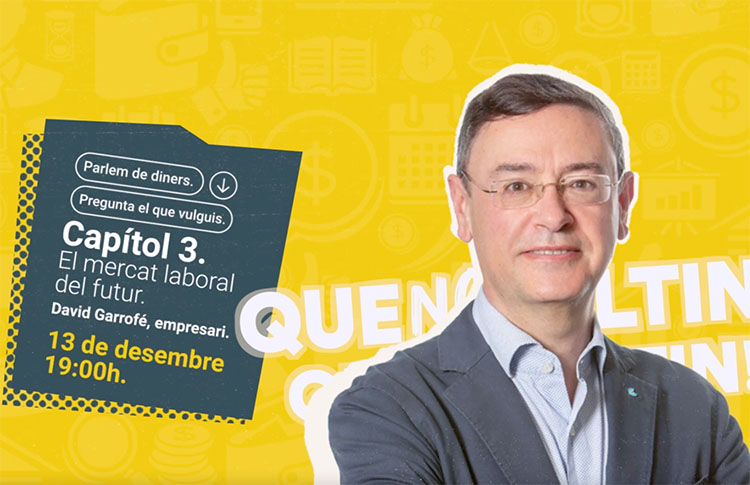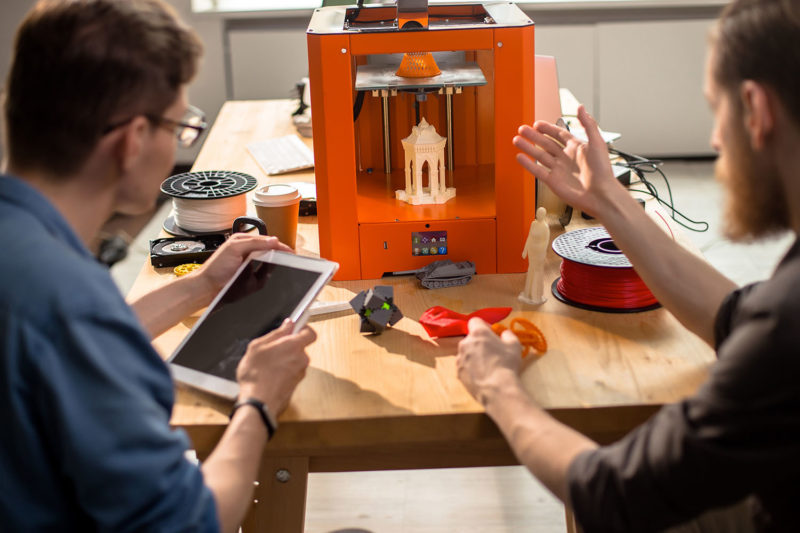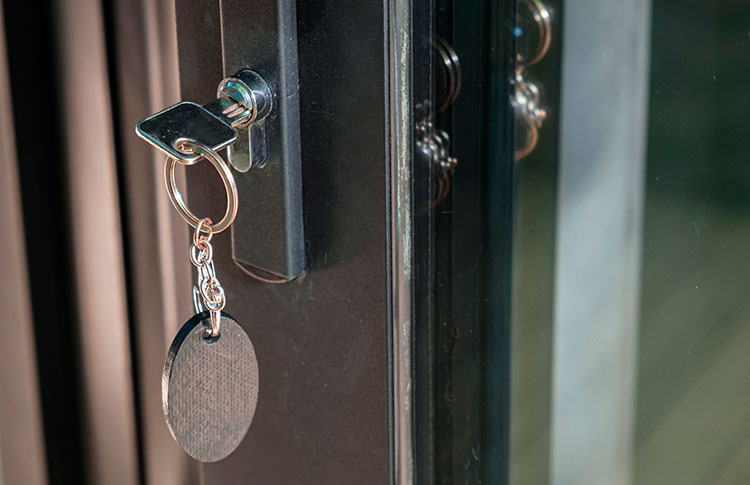Job market: the most valued cognitive skills
To find a job in the digital age, one needs more than just technical skills. Interpersonal qualities are critical to success in an increasingly complex and diverse work environment. Professionals who can master these competencies will be better prepared to thrive and face the challenges and opportunities presented by the labour market of the future.
The new technological revolution we are experiencing has brought about an accelerated digitisation and automation of many tasks, driven by artificial intelligence, which is radically transforming the labour market. This radical evolution of the nature of work requires new skills and personal competencies that will be critical for future jobs.
It is a paradigm shift that is enabling a reduction in workload without reducing productivity and could also make it feasible to reduce working hours to facilitate work-life balance, reducing stress and improving workers’ health and well-being. Even so, it may have a negative impact on people by replacing some jobs with automation or reducing available working hours.
In this context, while some jobs will become obsolete, others will emerge to replace those that will disappear. We expect this to happen in terms of both quantity and quality of employment, but at the very least it will require effort and investment in education and training.
Problem-solving, creativity and adaptability
Although there will continue to be many skilled jobs that will see little change, the labour market will increasingly require more dynamic and creative professionals who have a strong ability to adapt to change.
In fact, according to a study by the Skills and Occupations Barometer of Catalonia, promoted by the Universitat Oberta de Catalunya (UOC) and PIMEC, this skill is most highly valued by companies when hiring future professionals. Specifically, it was found that 51% of job offers published in Catalonia in 2023 required this skill, which is also in demand in most sectors (96%) and occupations (68%).
Likewise, the most valued qualities are the ability to assume responsibility, manage time, and accept criticism. These data are especially relevant in ICT occupations, which also concentrate the demand for people with the ability to “think creatively” and “solve problems” which, on the other hand, is significantly requested in 70% of the sectors and 40% of the occupations,
On the other hand, the barometer found that the importance of “teamwork” is particularly concentrated in professional, scientific and technical activities, where 24% of vacancies require this skill. In any case, and as Antoni Cañete, president of Pimec, emphasised, we are talking about “soft skills”, which can be applied to all professions and refer to “very human, transferable and transversal” skills.
11Onze is the community fintech of Catalonia. Open an account by downloading the super app El Canut for Android or iOS and join the revolution!
Do we live in a meritocracy, where effort is rewarded? Does the social lift really work? Numerous studies question whether people’s socio-economic success depends on their merits or whether it is predetermined by the privileges granted by their place of birth or social class.
The saying that the future is in our own hands, which we have heard so often from our elders, is in question. At least if we do not belong to a wealthy family. An Esade study shows that equality of opportunity in Spain is a fallacy: it is 24 times easier to end up in the top 1% of the population if you come from one of the families with the highest income than if you belong to one of those with the lowest.
The situation in Catalonia is much better than in Andalusia or the Canary Islands, as it offers the highest level of absolute and relative intergenerational mobility in the sample, with rates similar to Scandinavia. But, even so, the social lift is clearly out of kilter.
A contested model
After leaving behind feudal society, which was made up of rigid estates, bourgeois society, based on theoretical equality before the law, was supposed to allow people from the lower classes to progress socially if they worked hard enough. Traditionally, education was the main way for the lower and middle classes to move up the ladder. However, more and more experts point out that education no longer guarantees anything and that meritocracy does not exist.
The idea that effort takes precedence over privilege in our society is fundamental to legitimising Western liberal political and economic systems. To maintain the established social order, most individuals must believe they can get ahead if they try hard enough.
However, as Harvard Law Professor Michael Sandel warns, “the first problem with meritocracy is that opportunities are not really equal for everyone“. In fact, in the so-called Ivy League universities, which include eight of the most prestigious in the United States, there are more students who belong to the top 1% of the country’s wealthiest families than to the bottom 60%.
Daniel Sanabria Lucena, Professor of Psychology at the University of Granada, adds that in reality “the best predictor of academic performance and later professional success is not cognitive performance, it is the socio-cultural context, that your parents have money.
The adventure of entrepreneurship
The success stories of young entrepreneurs such as Steve Jobs, who founded Apple in his garage, have become popular. However, these are not representative cases, but highly unusual, stories that only happen to one person in a million. Moreover, in many of these cases, there are determinants of success that go beyond merit and personal effort.
Research has shown that the most common characteristic among entrepreneurs is access to capital, either through family or contacts that facilitate financial stability. Rather than a genetic inclination, it is often money and a safety net that enables entrepreneurs to take risks.
In fact, famous research by economists David Blanchflower and Andrew Oswald indicates that personality measurements and psychological test scores do little to predict who will run their own business. In reality, “it’s the start-up capital that matters,” they state emphatically in their study.
In this regard, the latest Global Entrepreneurship Monitor, which analyses entrepreneurship around the world, warns that businesses are often started with money from family, friends and colleagues. And it should be noted that many startup founders do not draw a salary for some time, something few people can afford.
The rich of yesterday and today
It seems that the wealth of family dynasties is perpetuated over time much longer than previously thought, as research by Italian economists Guglielmo Barone and Sauro Mocetti suggests. By testing intergenerational mobility and wealth distribution in Florence by comparing records from 1427 with those of 2011, they found that the wealthiest Florentine families still had the same surnames almost 600 years later. And other studies suggest that this is not a phenomenon unique to Tuscany.
Individual effort is no guarantee of success for young people today. A Spanish government report even acknowledges that “being born into a low-income family conditions educational and development opportunities much more than in other European countries”. Poverty is increasingly becoming a cage with no way out for a significant part of the population.
While qualifications and specialised training generally increase employability and average income, most analyses show that those sections of the population that are born into a social position tend to live and die in that position.
Indeed, young people have seen their present ignored and their future mortgaged. In recent years, when it comes to cutting large budget items, education has fared much worse than health and pensions. As a result, the main dynamo of the social lift is squeaking more than ever. And the amount of public debt they will have to pay off in the coming years has skyrocketed.
11Onze is the community fintech of Catalonia. Open an account by downloading the app El Canut for Android or iOS and join the revolution!
To transform an idea into a business, it is essential to have a global vision of the business project. The Business Model Canvas is a strategic management tool that allows you to organise and visualise all the key aspects of a company. Xavi Viñolas, Content Manager at 11Onze, explains how to use it.
If we want to create a company, it is not enough to have a business idea and an entrepreneurial spirit. To find out if a business project is feasible, you have to create a business plan that takes into account all areas of the business over a long period, to analyse the feasibility of the project, defining the objectives and considering the drawbacks.
What is the Business Model Canvas
The Business Model Canvas is a template that allows us to analyse and visualise a business proposal or the opacities of an existing business in a clear, agile and simple way. This allows you to prevent the business objectives from being unclear, unrealistic, or inadequate.
It is also an ideal tool for creating innovative models to generate value for customers. As Xavi Viñolas explains, “It is a very useful tool to explain to potential investors or partners how our business provides value to the consumer and, at the same time, how this consumer creates value for our business”.
The 9 building blocks of the template
Alexander Osterwalder, the creator of the Business Model Canvas, explains the concept: “The best way to describe a business model is to break it down into nine basic building blocks that reflect the logic a business follows to achieve revenue. These nine building blocks cover the four main areas of a business: customers, offerings, infrastructure and economic viability”.
- CUSTOMER SEGMENTS. That is, who is this business aimed at? Who is our customer? What is our market segment?
- VALUE PROPOSITIONS. Quite simply, what products or services do you offer that create value for your customers? What makes us different?
- CHANNELS. How is this product or service distributed? Is it an intangible product or service that you sell through an app or a website? Is it a product or service that has to be sold or provided through a physical shop or office?
- CUSTOMER RELATIONSHIPS. Here we describe what kind of relationships we have with our customers. Are we targeting a customer who will only buy from us once? Or do we have a business that is looking for a recurring customer, such as a subscription?
- REVENUE STREAMS. How do we monetise the business – is it a direct sales proposition or a recurring subscription model? How do we price our product?
- KEY RESOURCES. These can be your factory, your employees, intellectual property, things, or people that are essential to your business.
- KEY ACTIVITIES. Activities that you do with the key resources and that are necessary to realise the value proposition: marketing, production, sales.
- KEY PARTNERSHIPS. The people or organisations you need to execute your business model and produce value for your customers.
- COST STRUCTURE. And finally, all this will cost you money, right? What fixed, and variable costs determine our business model? Is it a scalable model?
If you want to find out how to get returns on your savings with a social justice product, 11Onze recommends Litigation Funding.
Cansat de treballar des de casa? Fes-te nòmada digital i porta l’oficina allà on vagis. Un nou format de teletreball que et permet sortir de la rutina i viure experiències que mai viuries des del menjador de casa.
La premissa: sortir de la rutina. Perquè fora de la zona de confort és on passen coses, i quan ens trobem en una situació relaxada és quan sorgeixen les millors idees. La rutina, l’estrès de la ciutat o la jornada laboral al mateix despatx durant anys i anys ja no és l’única opció. Cada vegada són més les empreses que aposten pel teletreball, amb alts índex de resultats pel que fa a productivitat i eficiència. I una tendència, també, a la qual cada vegada més treballadors s’apunten.
L’auge ha estat especialment significant en persones joves, però cada vegada es difon més l’edat, en una tendència que suma més beneficis que inconvenients. Actualment, els estudis demostren que el 85% d’empreses augmenten la productivitat gràcies al teletreball. La mitjana d’edat dels nòmades digitals se situa a 32 anys i, només als Estats Units, el nombre de nòmades digitals ha passat de 4,8 milions (2018) a 10,9 milions (2020). D’aquests, només el 34% té planejat tornar a l’oficina passat un any.
Espanya, destí de nòmades digitals
ETIAS, el sistema europeu d’informació i autorització de viatges, ja contempla el teletreball, és a dir, els nòmades digitals, com un dels principals atractius per a molts països. A partir del 2022, els ciutadans europeus podran moure’s per l’anomenada Àrea Schengen durant 90 dies consecutius gràcies a l’autorització d’ETIAS.
A Espanya, aquest mateix any s’aprovava la Llei de Start-ups, que crea un nou tipus de visat per seduir als teletreballadors d’arreu del món i aconseguir així que escullin el país com a destí de treball. Això sí, des d’una mentalitat diferent, i és que per als nòmades digitals viure i conèixer l’entorn passa fins i tot per sobre de la rutina laboral.
Croàcia, Estònia o Les Bahames també es posicionen al capdamunt de la llista de millors països on ser nòmada digital. I tot i que a cada país la normativa és diferent, s’intenta adaptar-la per facilitar els tràmits de residència i, fins i tot, beneficiar-los en el pagament d’impostos.
Què cal tenir en compte abans de començar?
- No oblidis que vas a treballar. Busca llocs que t’assegurin bona connexió a internet i accés a punts d’energia.
- Sigues productiu. Aquesta aventura ha de servir per treure la teva part més creativa, no permetis que les distraccions del nou hàbitat suposin un inconvenient.
- Crea la teva rutina. Tinguis horaris de treball definits per l’empresa o no, crear una rutina de treball serà el teu millor aliat per ser eficient, i així poder gaudir del temps lliure.
- Atreveix-te a socialitzar i conèixer cada lloc que visitis amb profunditat, especialment si viatges sense acompanyant.
- Escull un país que econòmicament et sigui beneficiós. La relació entre el teu sou i el cost de vida del país de destí t’hauria de permetre viure més còmodament.
- Aprendre a viure amb menys. L’únic imprescindible serà l’ordinador i el mòbil.
- Desenvolupa noves habilitats. Aprendre un idioma, fer noves activitats, formar-te en línia… tindràs accés a més ventall formatiu i, el més important, a un major mercat laboral.
Avantatges i inconvenients s’entrellacen en aquesta nova modalitat de teletreball marcada per la llibertat d’escollir el rumb de la teva vida, dia a dia. I tu, series capaç de deixar l’oficina i convertir-te en nòmada digital?
Vols ser el primer a rebre les últimes notícies sobre 11Onze? Clica aquí per subscriure’t al nostre canal de Telegram
Have you ever had the feeling that you are wasting time while attending a meeting with your teammates and/or your boss? You are in the meeting, but are you thinking about other things? Can these sensations be avoided by making meetings more efficient? We try to explain how.
According to team building and leadership specialists, one of the essential issues is to be clear about why you are calling a meeting. Sometimes, we have the feeling that we are in that room, simply because you have been told to or because it’s on the calendar, without a defined objective.
Nowadays, and after everything that has happened in the last year, there are also those who distinguish between the organisation of face-to-face meetings and virtual meetings, given that the latter are not always easy to control, either because everyone is talking at the same time or because the attendees’ connections start to fail.
But in any case, the essential guidelines are the same:
- Before convening a meeting, whether it is face-to-face or virtual, we must be clear about the objective: What do we want to achieve? Is it really necessary?
- If possible, it should be planned with enough time to inform the interested parties, so that they can prepare for the meeting as well as the convenor, and so that the time is used to the maximum. Similarly, if necessary, it is advisable to provide attendees with the necessary documentation.
- The invitation should only reach the essential people. There is no point in having 20 people attending if only 5 are really interested and/or affected. For the company, time is money, and it is not productive to have a lot of people as forced spectators.
- Calculating the duration of the meeting is also important to avoid it taking longer than necessary, and obviously you have to be punctual in order to keep to the timetable. When calculating the duration of the meeting, we must think about setting aside time for requests and questions that can be asked at the end of the meeting.
- The space where the meeting is held, in the case of face-to-face meetings, must be adequate for the number of people convened, and must have all the technological and analogue tools necessary to clearly set out all the issues to be discussed.
- Once in the meeting, we have to assign the “role” that each of the attendees has to assume, if the interventions have to be marked. What is clear is that there must be a moderator, who will usually be the convenor, to avoid diluting the objective for which we are meeting.
- For a correct development, before starting, the moderator must read the agenda in order to be clear about the issues to be discussed or resolved, and make clear the reason for the meeting. From this point onwards, he or she must ensure that the time allocated to each of the topics and speakers is respected, so that the established timetable is adhered to and everyone can make their points.
- Once all the scheduled interventions have been completed, it is time for Q&A, in order to polish the topics dealt with, resolve any doubts that may have arisen, and decide whether any new contributions should be made before ending the session.
- In the closing session, it is important to define the conclusions drawn, as well as the solutions to the problems that have arisen during the meeting, and the deadlines for carrying out the actions to be undertaken.
- Finally, it is important to draw up a summary or a record of the minutes that includes everything that has been presented, interventions, conclusions, and even details the decisions that have been taken and the actions that must be carried out from now on.
The achievement of all these premises should guarantee effective and efficient internal meetings, meetings with suppliers and meetings with clients, so that we do not end up with a feeling of wasted time. It is especially important to make the most of time in order to achieve productivity and efficiency objectives that generate the economic benefits necessary for the survival of an organisation, thus guaranteeing the professional and personal stability of all those involved.
Do you want to be the first to receive the latest news about 11Onze? Click here to subscribe to our Telegram channel
According to the Idescat, this June 2021 there were 445,862 unemployed people. Of these, more than half (54%), specifically 240,564 people, belong to the age group of more than forty-five years.
These shocking data reflect that it is people close to the age of fifty who find it most difficult to get a job. What is happening?
We need to ask ourselves if we can move forward as a society without counting on people who can best add value to jobs. How can the people who can bring experience, seriousness, rigour, and talent to a company be the people who find it most difficult to get a job?
Being over fifty: difficulty or opportunity?
Everything basically points to a problem of business culture, given that experience is undervalued. Apart from wanting to save and not value enough the opportunity involved in having a young worker and a senior worker together, an unstoppable tandem, the resumes of senior professionals are automatically ruled out. So, until there is a change of mindset, it will be difficult to find a solution to this nefarious problem. One of the worries of people around the age of fifty looking for work is that they are closer to retirement age. But this should not be a hindrance, as they are people with more professional background and more experience than young people, and this is an added value.
Now, what can we do if we are in this situation? Here are 11 tips we give you so that finding a job beyond your fifties is an opportunity:
- Be always eager to learn, especially digital skills.
- Keep training. This attitude is one of the most valued.
- Be optimistic and ask for help to find a job. Be positive and consistent!
- Have patience and hope, know how to manage negative feedback, and work on resilience.
- Make a curriculum designed for each job offer.
- Even if you have a very long work experience, explain only that of the last 15 or 20 years.
- Be clear on which sector you want to work.
- Do not include in your CV your marital status, children, or too personal data.
- Take advantage of public resources offered by your city council, County Council… You will surely find some resources to help you find a job.
- Look for opportunities in the sectors that have been strengthened by the health crisis: technology, pharmacy, education, health, and so on.
- Get active on social media. Make a good LinkedIn profile, a good network of contacts, and make yourself known!
Being positive is one of the first things we need to be clear about when it comes to finding a job. Remember that no matter what happens, and no matter what it costs to find it, the opportunity is always there, because the sun rises every day.
Do you want to be the first to receive the latest news about 11Onze? Click here to subscribe to our Telegram channel
El raonament és senzill i potent alhora: l’actiu més important i rendible de qualsevol empresa són els seus treballadors i treballadores. Aleshores, què pot ser millor que mantenir l’actiu més important de l’organització en el seu estat natural, que és on es manifesta tot el seu potencial?
Aquest raonament, però, no és d’aplicació exclusiva a l’àmbit laboral. Les seves connotacions són primordials, ja que totes les persones som treballadores, si més no en potència, sigui en l’àmbit laboral actiu, postlaboral, en l’àmbit acadèmic, o en qualsevol altra situació. És evident, doncs, que la felicitat transcendeix qualsevol d’aquests raonaments, per a anar a raure en el comú denominador: l’ésser humà.
La recerca científica de la felicitat
Parlar de la felicitat no és cap novetat, Aristòtil ja en feia profundes dissertacions al segle IV aC. Però, en els últims anys, ha pres força el concepte de psicologia positiva, que és un corrent de la psicologia que estudia les bases del benestar psicològic i de la felicitat, així com de les fortaleses i virtuts humanes. La diferència respecte a altres corrents propers de la psicologia i amb els seus precedents històrics és que aquest es basa en el mètode científic. El psicòleg Martin Seligman en va establir les bases a la fi dels anys 1990, i d’altres autors, com Mihály Csíkszentmihályi, l’han fet créixer amb les seves contribucions.
A primer cop d’ull, el propòsit de la psicologia positiva pot sonar massa arrogant: «ara la ciència pretén explicar-nos què és la felicitat?». Però són moltes les veus dissidents que consideren que la felicitat va molt més enllà del processament d’un simple conjunt de valors mesurables en l’àmbit de la psicologia.
Debats a banda, totes les persones sabem, sense que ens hagi calgut aprendre-ho, quan ens sentim bé, i, sobretot, quan ens sentim malament. És quelcom innat. I és que el nostre organisme va com una seda amb el benestar, mentre que comença a donar senyals d’alerta quan experimentem malestar.
Què en diuen els experts
Atès que les empreses són sobretot conjunts de persones, pot semblar que sigui bàsic garantir el benestar i la satisfacció dels treballadors a la feina. Tanmateix, en la lògica empresarial lligada a la Revolució Industrial (encara molt present arreu), el paradigma general ha estat tot el contrari: fer-los treballar al màxim per a obtenir majors beneficis. Una visió on el seu benestar personal queda lluny de la incumbència de l’empresa.
Els estudis sobre aquest tema arriben a la conclusió que l’experiència dels treballadors que se senten a gust a la seva organització és molt més preuada que, fins i tot, els béns materials que poden rebre com a gratificació. I això és perquè aquesta experiència no té caducitat; sempre pot ser evocada i gaudida de nou.
La felicitat dels treballadors com a baròmetre de la salut empresarial
Així doncs, ara ja no es tracta de centrar-se només en la famosa experiència de client (CX), sinó que l’experiència del treballador també juga un paper cabdal en l’èxit de l’organització. Tant des del punt de vista de l’empresa, perquè un empleat feliç, creatiu o empàtic és sinònim d’un treballador més productiu, com des del punt de vista del treballador, perquè passem gairebé un terç de la nostra vida a la feina.
És bona mostra de la consolidació d’aquesta tendència el sorgiment de diversos índexs, com ara l’Índex Global de Felicitat en el Lloc de Treball, que mesuren la felicitat al lloc de treball. Així mateix, es consolida la figura coneguda com a Chief Happiness Officer o director de benestar en aquelles organitzacions que aposten pel valor de les persones i la rendibilitat d’un empleat feliç.
La difusió aconsegueix conscienciació i implicació
Persones i empreses són una estranya barreja. Les persones som éssers tangibles que actuem moguts per la gratificació; posem els nostres esforços en allò que ens gratifica, sigui en la forma que sigui. Tanmateix, les empreses són en si intangibles, tot i que alhora estan formades per persones, i tenen com a propòsit o bé el benefici propi, el benefici social (sense afany de lucre) o bé una combinació de les dues, que aporti benefici però de forma sostenible per a la societat.
Estranya barreja i, alhora, quina sinergia tan fructífera quan el focus de l’organització es posa en les persones!
A 11Onze s’ha cregut des de bon principi en aquest valor fonamental, que és compartit per totes les persones que formen la nostra comunitat. I funciona!
Si vols que el teu negoci faci un gran salt, utilitza 11Onze Business. El nostre compte d’empresa i autònoms ja està disponible. Informa-te’n!
Els diners formen part de la nostra vida des de ben petits. Amb les primeres monedes que posem a la guardiola, els diners que ens donen els avis per l’aniversari, la primera feina d’estiu, l’ajuda dels pares per comprar-nos els primers capricis… I de sobte, arriba la majoria d’edat i, entre molts d’altres canvis, per primera vegada tenim el control sobre els nostres diners. Però realment ens han ensenyat a gestionar-los? Serem capaços d’independitzar-nos, d’arribar a final de mes? La resposta és que, sens dubte, sí, controlar tot això està a les nostres mans, i només necessitem una mica d’organització per treure’n el màxim rendiment.
Per què necessito els diners?
El primer estereotip que hem de trencar respecte als diners és comparar-nos amb els altres. Calcular el que tenim o guanyem en funció del que té la gent del nostre entorn no és ni ser objectiu ni realista. Cadascú neix i creix dins un entorn determinat, en unes condicions sobre les quals rarament ha pogut influir. Si estàs estudiant i tot just comences a encaminar el que serà la teva vida, treu-te la pressió de sobre, perquè res està escrit, i l’important no és on comences sinó on pots arribar. Així doncs, el primer que ens cal fer és analitzar la situació actual i determinar el nostre objectiu a mitjà termini. No serà el mateix viure a casa dels pares i centrar-nos en els estudis que tenir la voluntat d’independitzar-nos, encara que per aconseguir-ho hàgim d’invertir part del nostre temps en treballar. Determinar això ens portarà a la següent pregunta: quants diners necessito per viure?
En aquest punt ja hem de començar a jugar amb les nostres finances i diferenciar les despeses fixes de les variables, tal com fan les empreses. Les fixes seran totes aquelles que tenim tant sí com no cada mes, com ara el lloguer del pis, el gimnàs, el preu de la targeta de transport o una subscripció a Spotify. En el cas de les variables, seran totes aquelles en què l’import pot variar d’un mes a l’altre en funció de les nostres necessitats. Per exemple, tot i que el menjar és imprescindible, no gastarem el mateix un mes que l’altre, i justament és un dels punts on podem retallar despesa. Amb això no ens referim a deixar de menjar o comprar els productes més econòmics del mercat, independentment de la seva qualitat. Més aviat ens referim a tot el contrari: apostar per un consum més responsable.
Com puc reduir la meva despesa mensual?
Només cal mirar l’entorn actual per veure que les tendències de consum, és a dir, el tipus de compra que fa la major part de la societat, està canviant, i cada vegada són més les persones que en comptes de comprar en grans superfícies industrialitzades busquen el producte de proximitat, més qualitat i menys quantitat. Aquests petits canvis ens permetran fer una compra amb consciència, prioritzant només els productes que necessitem i cuidant al mateix temps la nostra salut i economia. Algun exemple que podem aplicar a la nostra vida diària podria ser beure aigua en envasos reutilitzables (ampolles de vidre o metàl·liques) i evitar així la compra diària d’ampolles d’aigua, tot substituint-les per garrafes que són més econòmiques i ens duraran més temps.
El mateix podem fer a l’hora de la compra, portant la nostra bossa per evitar comprar bosses de plàstic. Un altre truc útil pot ser organitzar el nostre menú setmanal, per saber què menjarem cada dia i, per tant, què ens cal comprar. Ni més ni menys. Pel que fa a productes d’higiene, podem optar per paquets familiars, on hi ha més quantitat per menys preu, o bé alternatives com les pastilles de sabó o les copes menstruals que, més enllà de ser econòmiques, no generen residus. També existeixen botigues a granel on pots comprar només la quantitat que necessites, sigui de productes alimentaris o de neteja de la llar. Investiga la teva zona i busca l’opció que més s’adapti a la teva butxaca, recordant sempre que allò que s’ha fet sempre, o allò que fa la majoria, no sempre és la millor opció per tu.
Pel que fa al transport, també cal buscar aquest equilibri i valorar alternatives al transport privat, que suposa un cost més elevat si sumem gasolina, impostos, assegurança i reparacions. El transport públic o la bicicleta són dues opcions econòmiques que ens poden ajudar a controlar les nostres despeses al mateix temps que cuidem el medi ambient. Fins i tot en el moment de sortir de festa podem retallar despeses si actuem amb consciència. Reservar amb antelació, aprofitar ofertes i descomptes o marcar-nos la quantitat que volem gastar abans de començar la nit ens ajudarà a mantenir un cert control. Si aquesta última part és la més difícil, un truc pot ser portar en efectiu l’import que volem gastar. D’aquesta manera, no hi haurà marge de passar-nos de pressupost i això ens permetrà gestionar millor les sortides, sense gastar ni un euro més del que toca.
Controla la teva situació econòmica des del mòbil
Aquestes són algunes de les recomanacions que ens ajudaran a mantenir el control dels nostres estalvis, però la tasca important és analitzar la nostra situació particular i fer-nos les següents preguntes: de quins ingressos disposo? Quina quantitat he de destinar a despeses fixes? Què em queda per destinar a l’oci? Necessito estalviar de cara al futur?
Si una cosa tenim a favor, és que actualment existeixen aplicacions per gairebé tot. Controlar les nostres finances mai ha sigut tan fàcil. La majoria d’entitats financeres s’estan posant les piles des de fa anys perquè l’experiència del nou client digital sigui intuïtiva i àgil, de manera que en un sol clic tinguem a la nostra disposició tota la informació que desitgem, des del saldo total del compte (els diners de què disposem), fins a les despeses que hem realitzat amb la targeta, veient de manera gràfica on estem destinant la major part dels nostres diners. Això ens permetrà fer-nos una idea de la nostra situació actual i cap a on hem de dirigir els esforços futurs.
Treballar i estalviar, els dos grans aliats per tenir diners
Una eina clau per gestionar els nostres estalvis són les guardioles digitals, un espai del compte on posarem els diners que volem destinar a una activitat concreta. El funcionament n’és senzill: ens hem de proposar un objectiu, sigui un viatge o alguna cosa que volem comprar, i a partir d’aquí calculem quin import hauríem d’ingressar cada mes per aconseguir-lo. Cal buscar l’equilibri entre allò que desitgem i els nostres recursos actuals. Si volem més diners, haurem de treballar més. Si no podem treballar més, els haurem de gestionar de forma més eficient. Però, sigui quina sigui la nostra situació, prendre el control de les nostres finances i saber en tot moment què està passant al nostre compte corrent és indispensable.
L’últim consell és no perdre de vista que mai caminem sols. Tenim pares, familiars i molta gent al voltant que ens pot ajudar a entendre què significa tot allò que té a veure amb els diners, que, en definitiva, és entendre com funciona el món actual. Tenir el seu suport i seguir els seus consells serà un pilar indispensable perquè aquest primer contacte amb el món de les finances sigui clar i comprensible. Quan prenem el control dels nostres diners, estem prenent el control de la nostra vida.
11Onze és la comunitat fintech de Catalunya. Obre un compte descarregant la super app El Canut per Android o iOS. Uneix-te a la revolució!
T’has llegit la pòlissa de la teva assegurança de la llar? L’error més habitual en contractar una assegurança és no revisar quines cobertures inclou la pòlissa. Per evitar sorpreses desagradables d’última hora, et detallem alguns punts del contracte en els que t’has de fixar.
La cobertura de continent cobreix els costos de reparació o reconstrucció del teu habitatge en cas de desgràcia. Per a diferenciar-ho del contingut, una fórmula molt gràfica és imaginar que podem posar el nostre habitatge cap per avall. Tot el que cauria seria contingut, mentre que el que no cauria seria continent.
Cal tenir en compte que el valor de la cobertura de continent no representa el preu de compra o el valor de mercat del teu habitatge. Tampoc hauria d’incloure el valor del sòl sobre el qual es va construir la casa o l’edifici. En realitat, és la quantitat que es necessitaria per reconstruir l’habitatge i deixar-lo com estava. Aquest valor es coneix com a “cost de reconstrucció”.
L’assegurança de llar també inclou una secció dedicada al “contingut”, és a dir, les teves coses (televisor, roba, ordinador, bicicleta, etc.). L’import que apareix en aquesta secció és la quantitat que l’assegurança et pagarà com a màxim si passa alguna cosa amb les teves coses, d’aquí que hagi de correspondre’s més o menys amb el seu valor real.
Les clàusules de la pòlissa, a examen
Aquí tens alguns elements que hauries de tenir en compte per no pagar de més i que l’assegurança no et pagui de menys en cas de sinistre:
- Evita duplicitats. Si la teva finca té assegurança, comprova les seves cobertures, ja que podràs excloure de la pòlissa particular els elements del continent que ja estiguin inclosos en l’assegurança comunitària. Tingues en compte que, en cas de sinistre, si un element està cobert tant per l’assegurança comunitària com pel teu particular, no el cobraràs dues vegades.
- Assegura’t que la valoració del continent és correcta. Si els capitals assegurats estan molt per sobre del valor de la teva casa, estàs pagant per una protecció que no necessites, ja que en cas de sinistre l’assegurança només pagarà la reconstrucció, res més. I, en el sentit contrari, si el valor de reconstrucció de la teva casa està per sobre dels capitals assegurats, l’asseguradora només pagarà fins als capitals assegurats, deixant-te coix en la teva recuperació. Per tant, has d’ajustar la pòlissa perquè estigui lleugerament per sobre del valor de la teva casa, però sense pagar per una cobertura innecessària. De manera orientativa, tingues en compte que la valoració hauria d’oscil·lar entre uns 800 euros per metre quadrat en els pisos normals i els 1.300 euros en una casa unifamiliar.
- Comprova que la valoració del contingut és adequada. Tingues en compte que les assegurances imposen límits al valor individual de les teves coses que cobreixen per defecte. Normalment, els teus objectes valuosos necessitaran una cobertura addicional. Per tant, cal que els donis d’alta o la teva companyia només et retornarà fins al límit individual que tens per defecte en la teva pòlissa. Et recomanem fer fotos (o un vídeo) de totes les teves coses. Per a estimar el seu valor, convé fer primer una llista amb els objectes de valor i calcular el seu cost, i després estimar la xifra dels articles menys valuosos, com roba i utensilis de cuina, i arrodonir el seu valor.
- Vigila com es reflecteix la cobertura dels vidres. La cobertura de vidres inclou des de finestres fins a miralls. Has d’assegurar-te que les finestres s’incloguin dins del capital i cobertures de continent, mentre que els miralls interiors s’inclouen en el contingut. De vegades les asseguradores utilitzen aquesta separació per excloure part dels vidres de la cobertura, així que fixa’t si tots estan coberts.
- Tingues en compte la cobertura dels danys estètics i la pisa sanitària. Banys, plaques de cocció i altres elements han d’estar protegits per aquestes cobertures. Algunes asseguradores inclouen aquests elements com a part del contingut, la qual cosa pot perjudicar-te si el capital assegurat està per sota del real. A més, pot fer que banys i cuines quedin fora de cobertures específiques, com els danys estètics, si només es cobreixen els danys del continent i banys i cuines es consideren contingut. Has de comprovar que la cobertura de danys estètics cobreix les reparacions necessàries per a mantenir la uniformitat estètica de la teva casa després d’un sinistre, ja que les asseguradores juguen molt amb les limitacions d’aquesta cobertura, especialment en banys i cuines. Comprova que la teva pòlissa cobreix la pisa sanitària com a continent i no té exclusions ocultes. Ni tampoc els danys estètics, que han de cobrir un capital mínim de 2.000 euros.
- Assegura’t que l’assegurança cobreix el valor de reposició del contingut. El valor real és el valor que calculen la majoria de les asseguradores per a substituir les teves coses robades o danyades. Es calcula partint del que costaria avui aquest mateix article (el valor de reposició) restant la pèrdua de valor a causa de l’edat, el desgast i els trencaments (depreciació). D’aquí la importància que l’assegurança no cobreixi el valor real, sinó el valor de reposició, que ve a ser el preu pel qual es podria comprar avui el teu article (de la mateixa marca i model) si fos nou. En definitiva, el valor de reposició és el preu de mercat. Si la teva assegurança utilitza el valor real, probablement et compensa buscar una assegurança amb preu similar que utilitzi el valor de reposició.
- Comprova que la pòlissa s’inclou defensa legal. Sense aquesta cobertura, la teva assegurança no t’oferirà el suport d’un advocat en cas de conflicte legal. Aquesta és una de les primeres cobertures que les asseguradores tendeixen a retallar per oferir preus més baixos.
- Repassa si el preu contempla els elements de seguretat. El fet de posar una porta de seguretat fa que la majoria de les assegurances abaixin el preu de les cobertures relacionades amb robatori. I el mateix succeeix amb mesures de seguretat com a alarmes o reixes. També elements com a sensors de fum o aigua haurien d’ajudar-te a reduir el preu de les cobertures relacionades amb aigua i foc. Assegura’t que aquests modificadors estan inclosos en la teva assegurança si els tens.
Com a resum, podem destacar que és fonamental que revisis els capitals assegurats i l’adequació a les característiques del teu habitatge; comprovis que tots els límits són correctes i cobreixen allò que esperes, i que la teva assegurança contempla alguns modificadors en el preu per ajustar l’import que pagues cada any als canvis que realitzes en la teva llar.
Si vols conèixer una assegurança justa per a la teva llar i per a la societat, descobreix 11Onze Segurs.
Unemployment rises slightly in Catalonia in July, despite the fact that the employment record has been maintained. But can we trust the reliability of the official data? Are there inactive workers who should be counted as unemployed?
Catalonia has registered an upturn in unemployment after five consecutive months of a downward trend. According to data published by the Ministry of Labour, during July, the Catalan labour market added 1,612 more unemployed people (+0.49%) than in June. Despite this slight increase in unemployment, it remains the lowest unemployment figure since the 2008 crisis.
Currently, there are a total of 331,356 unemployed people, but in the last year, the total number of unemployed has been reduced by 10,035 people, 2.94% less. Compared to 2022, there are 103,185 more contracts, which is equivalent to a 2.8% increase. In total, there are 3.75 million workers in Catalonia and an unemployment rate of 8.44%.
The unemployment figures for Spain as a whole also reflect the best figures for 15 years. The Spanish economy continues to create jobs and reduce unemployment for the fifth consecutive month, although the pace slowed in July to below the historical average. The active population increases to 23.8 million people and the number of employed exceeds 21 million, another record high.
Unemployment stood at 11.6%, a fall of 11.7 points, after 365,300 people found work in the second quarter of the year, adding 595,614 people to Social Security since January. On the other hand, the number of unemployed registered at the offices of the public employment services fell by 10,968 people in July, -0.41% compared with the previous month, to a total of 2.68 million.
Inactive workers who are not registered as unemployed
In March 2022, the latest labour reform came into force, one of the main objectives of which was to change the production model, moving from temporary to permanent contracts in order to reduce temporary employment and precariousness. Therefore, work and service contracts disappeared, while the possibility of temporary contracts was restricted to very specific situations that cannot exceed 90 days worked per year.
In exchange, it was proposed that companies should use fixed-term contracts so that people doing seasonal work would not have to worry about whether their contract would be renewed after a period of inactivity and would have the same rights as workers with a permanent contract.
Despite the benefits for employees that this type of contract brings, it has the counterpart that workers who were previously considered unemployed are no longer counted as unemployed. In other words, when an employee with a fixed-term contract enters a period of inactivity, he or she receives unemployment benefits, but is not counted as unemployed, but is considered a “jobseeker with an employment relationship”.
This is a significant number of people who, in Catalonia alone, last year accounted for 5.7% of all workers affiliated with Social Security in Catalonia under this type of contract. If we take figures for the whole of Spain in December 2022 and January of this year, they were equivalent to 443,078 and 660,000 unaccounted jobseekers.
Obviously, the official data do not include the people who are looking for work but who are not registered with the SOC or the SEPE, either because they are self-employed, because they do not make any profit, or because they are part of the underground economy. Nor is it specified how many people work part-time, not because they want to, but because they cannot find another full-time job.
And it is true that these figures are difficult to account for, but more transparency in the data related to discontinuous permanent workers does not require any effort, but the simple will to reduce the divergence between the reality of the labour market and the official rhetoric, an unavoidable necessity if we really want to evaluate the effectiveness of employment policies.
Do you want to be the first to receive the latest news about 11Onze? Click here to subscribe to our Telegram channel






























